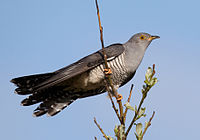
Photo from wikipedia
Temperature strongly drives physiological and ecological processes in ectotherms. While many species rely on behavioural thermoregulation to avoid thermal extremes, others build structures (nests) that confer a shelter against climate… Click to show full abstract
Temperature strongly drives physiological and ecological processes in ectotherms. While many species rely on behavioural thermoregulation to avoid thermal extremes, others build structures (nests) that confer a shelter against climate variability and extremes. However, the microclimate inside nests remains unknown for most insects. We investigated the thermal environment inside the nest of a temperate winter-developing insect species, the pine processionary moth (PPM), Thaumetopoea pityocampa. Gregarious larvae collectively build a silken nest at the beginning of the cold season. We tested the hypothesis that it provides a warmer microenvironment to larvae. First, we monitored temperature inside different types of nests varying in the number of larvae inside. Overall, nest temperature was positively correlated to global radiation and air temperature. At noon, when global radiation was maximal, nest temperature exceeded air temperature by up to 11.2-16.5 °C depending on nest type. In addition, thermal gradients of amplitude from 6.85 to 15.5 °C were observed within nests, the upper part being the warmest. Second, we developed a biophysical model to predict temperature inside PPM nests based on heat transfer equations and to explain this important temperature excess. A simple model version accurately predicted experimental measurements, confirming that nest temperature is driven mainly by radiation load. Finally, the model showed that nest temperature increases at the same rate as air temperature change. We conclude that some pest insects already live in warm microclimates by building their own sheltering nest. This effect should be considered when studying the impact of climate change on phenology and distribution.
Journal Title: Journal of thermal biology
Year Published: 2021
Link to full text (if available)
Share on Social Media: Sign Up to like & get
recommendations!